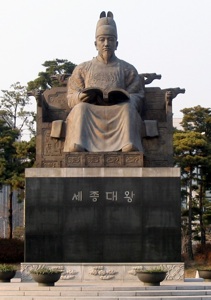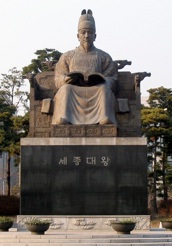
King Sejong and the Korean Hangeul Alphabet
On our recent visit to Korea we really enjoyed the National Palace Museum in Seoul and wanted to find out more about one of the famous kings. Why spotlight this king? He is considered to be one of the greatest Korean kings and is especially remembered for the development of Hangeul, the Korean alphabet. This is also the king who is on the face of the W10,000 note.
Recently (October, 2009) the newspaper, the Korea Times, had an article titled “Statue of King Sejong the Great Unveiled”. They reported that a new statue of Sejong the Great was unveiled in Gwanghwamun Plaza, in downtown Seoul, on the occasion of the 563rd anniversary of the invention of the Korean alphabet, Hangeul, in 1446. The statue is just behind the statue of Admiral Yi Sun-shin, the key Joseon Kingdom era military commander.
(Note that the exact date of the completion of the alphabet is not clear as some say it was 1443, others 1446).
King Sejong the Great is one of only two Korean kings to be called Great, and is regarded as one of the finest rulers in Korean history. King Sejong was born in 1397, and ascended the throne in 1418 at the age of 21. He was the fourth king of the Joseon dynasty (1397-1910). He died in 1450 at the age of 54 after ruling for 32 years. He ought not to have been king, as he had two older brothers. However, they were wise and realized their younger brother was the best future ruler for their country. So, they both pretended to be incompetent boors, and were deemed unfit to rule. The mandate to rule fell to the third brother, Sejong.
Without doubt, King Sejong was a remarkable man: a Confucian scholar, philologist, musician, poet, and a skilled swordsman. He believed a person needed to combine physical training with education and spiritual practices to become a whole person. He promoted research in the cultural, economic, and political heritage of Korea, and he sponsored many new developments in the areas of science, philosophy, music, and linguistics. To encourage young scholars to study, he established grants and other government support.
King Sejong believed that the basis of good government was a ruler with wide-ranging knowledge, virtue, and the ability to recognize and use talented men for government service.
As an administrator, King Sejong introduced many progressive ideas and reforms to improve the life of the common people. For example, in times of drought and flood, he established relief programs and opened centers to provide food and shelter. For farmers with poor harvests, he reinstated a loan system from the Goryeo Kingdom (918-1392) that loaned surplus grains to them from government stores, for repayment in kind with nominal interest.
Very early in his reign, in 1420, King Sejong established the Chipyon-chon (Hall of Worthies), a royal research institute. He had the best scholars and writers of the time compile many valuable works on history, geography, astronomy, mathematics, military science, agriculture, and pharmacology, which included encyclopedias on Chinese medicine and Korean medicine (hanyak). In addition, over the years King Sejong commissioned a large number of literary works, as he saw books as a way of spreading education among his people. One of the first works he commissioned was a history of the Goryeo Kingdom. Others included a handbook on improved farming methods to increase production, a revised and enlarged collection of model filial deeds, and an illustrated book of the duties and responsibilities in human relationships. A collection of King Sejong's own poems praising Buddha, entitled Worin Chon-gangjigok, was also published.
Realizing that literacy was key to a powerful nation, he gathered a group of scholars to develop a phonetic writing system that would correctly represent the sounds of spoken Korean and that could be easily learned by all people. The result was the creation of the Korean Hangeul alphabet, and this scientific alphabet is his best-known achievement. The system was completed in 1443 (or 1446). This alphabet allowed the general population to become more literate, as before this they were unable to master the classical Chinese language and script that was the official written language of Korea at the time. In addition, Chinese is very different to Korean in its vocal patterns and sentence formation and so could not represent Korean sounds and structure adequately. Like Hungarian, Turkish, Mongolian, and Finnish, Korean is classified with the Ural-Altaic language group. The Hangeul system is a simple alphabet, with 24 characters (10 vowels and 14 consonants), that is apparently easy to learn, and the shape of the characters actually instructed readers where to place their tongues, thus making it easier for uneducated people to grasp.
Initially, many scholars and government officials opposed the use of Hangeul. Despite this, King Sejong ordered popular poems, religious verses, and well-known proverbs to be translated into Hangeul to encourage its use. Hangeul was therefore also a political as well as a linguistic achievement.
King Sejong's rule is remembered as an age of peace and prosperity. Besides the creation of the alphabet, his masterful way of dealing with invading Japanese pirate ships made him beloved by the Korean people. King Sejong contributed to Korean civilization and society in a number of other ways, through his great understanding of then-current technology. He made improvements in the movable metal type that had been invented in Korea around 1234. He started the development of musical notation for Korean and Chinese music, helped improve designs for various musical instruments, and encouraged the composition of orchestral music. King Sejong also sponsored many scientific inventions, including the rain gauge, the sundial, a water clock, celestial globes, astronomical maps, and the orrery, a mechanical representation of the solar system.
Indeed, a king to be proud of.
An Amazing Ruler

Many believe...
The Korean Hangeul Alphabet is probably his greatest achievement





